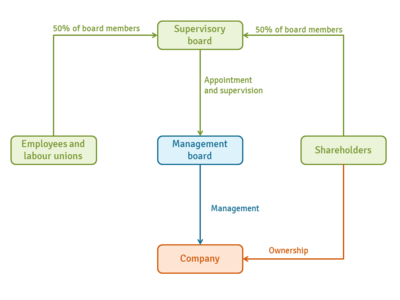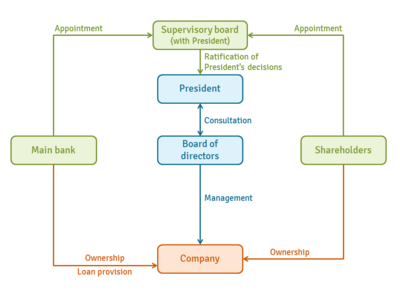Continental model of corporate governance: Difference between revisions
(Infobox update) |
m (→Main concepts) |
||
| Line 20: | Line 20: | ||
It is characterized by flexible contacts between investors and managers. This is a consequence of the frequent phenomenon of possession by banks and other financial institutions of large amount (often giving control) of shares in the [[company]]. Institutional and individual owners, through the selection of members of supervisory boards, are actively involved in the exercise of control over the actions of managers. A characteristic feature of this system for certain countries (e.g. for Germany) is significant role of workers' unions, whose representatives sit on supervisory boards and decide on important matters for the company and for themselves. | It is characterized by flexible contacts between investors and managers. This is a consequence of the frequent phenomenon of possession by banks and other financial institutions of large amount (often giving control) of shares in the [[company]]. Institutional and individual owners, through the selection of members of supervisory boards, are actively involved in the exercise of control over the actions of managers. A characteristic feature of this system for certain countries (e.g. for Germany) is significant role of workers' unions, whose representatives sit on supervisory boards and decide on important matters for the company and for themselves. | ||
[[File:German_model_of_corporate_governance.png|400px|right|thumb|Fig.1. German model of corporate governance]] | |||
Control in continental model is mainly exercised by supervisory council of the company and various committees (the [[audit]], remuneration, etc.). External mechanisms, such as, for example, capital [[market]], are inefficient, and their role is small. | Control in continental model is mainly exercised by supervisory council of the company and various committees (the [[audit]], remuneration, etc.). External mechanisms, such as, for example, capital [[market]], are inefficient, and their role is small. | ||
The continental model emphasises the development of the company and its long-lasting effects. Objective of the managers is above all development of the company, only later taken into account are the interests of shareholders and other interested groups. | The continental model emphasises the development of the company and its long-lasting effects. Objective of the managers is above all development of the company, only later taken into account are the interests of shareholders and other interested groups. | ||
[[File:Japanese_model_of_corporate_governance.png|400px|right|thumb|Fig.2. Japanese model of corporate governance]] | |||
== Main features of continental model== | == Main features of continental model== | ||
Revision as of 08:26, 8 September 2020
| Continental model of corporate governance |
|---|
| See also |
Continental corporate governance model (internal, Japanese) is a system of supervision and control over the corporation common in continental Europe and in Japan.
Main concepts
The main assumption of this system is to rely on banks, as institutions, which mobilize capital for development and investment. Due to the shallow and small financial markets, funding through the issue of shares and bonds is small.
It is characterized by flexible contacts between investors and managers. This is a consequence of the frequent phenomenon of possession by banks and other financial institutions of large amount (often giving control) of shares in the company. Institutional and individual owners, through the selection of members of supervisory boards, are actively involved in the exercise of control over the actions of managers. A characteristic feature of this system for certain countries (e.g. for Germany) is significant role of workers' unions, whose representatives sit on supervisory boards and decide on important matters for the company and for themselves.
Control in continental model is mainly exercised by supervisory council of the company and various committees (the audit, remuneration, etc.). External mechanisms, such as, for example, capital market, are inefficient, and their role is small.
The continental model emphasises the development of the company and its long-lasting effects. Objective of the managers is above all development of the company, only later taken into account are the interests of shareholders and other interested groups.
Main features of continental model
- Concentrated ownership of the shares,
- Substantial involvement of banks in the operations of the company,
- Weak market for corporate control,
- Shallow, insufficiently liquid financial markets,
- Orientation on the stability and development of the company,
- Low transparency in the capital market,
- Frequent skipping the interests of minority shareholders,
- The Board of Directors as an internal oversight mechanism
- Widely seen goal: long term development of the company,
- The large role of banks in financing of investments,
- A measure of the success of the company is the satisfaction of involved interest groups.
References
- Shleifer, A., & Vishny, R. W. (1997). A survey of corporate governance. The journal of finance, 52(2), 737-783.

